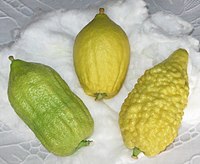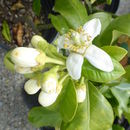Comments
provided by eFloras
Pomelo or shaddock includes cultivars with round to obovoid fruit much favored for festival decoration as well as eating. No truly wild plants (presumably with much smaller fruit) have been seen. Citrus maxima is a parent with C. reticulata of C. ×aurantium.
- license
- cc-by-nc-sa-3.0
- copyright
- Missouri Botanical Garden, 4344 Shaw Boulevard, St. Louis, MO, 63110 USA
Description
provided by eFloras
Trees. Young branches, abaxial surface of leaves, peduncles, and ovaries pilose. Branches usually purplish, flat with ridges when young. Petiole 2-4 × 0.5-3 cm or less, winged; leaf blade broadly ovate or elliptic, 9-16 × 4-8 cm or larger, thick, dark green, base rounded, apex rounded to obtuse and sometimes mucronate. Flowers solitary or in racemes; flower buds purplish or rarely milky white. Calyx 3-5-lobed. Petals 1.5-2 cm. Stamens 25-35, some undeveloped. Style long and thick. Fruit pale yellow and yellowish green, globose, oblate, pyriform, or broadly obconic, usually more than 10 cm in diam., with large prominent oil dots, to 200-seeded or seedless; pericarp spongy; sarcocarp with 10-15(-19) segments, white, pink, reddish, or rarely milky yellow. Seeds irregularly shaped, with conspicuous ridges, undeveloped seeds numerous; embryo solitary; cotyledons milky white. Fl. Apr-May, fr. Sep-Dec. 2n = 18, 36.
- license
- cc-by-nc-sa-3.0
- copyright
- Missouri Botanical Garden, 4344 Shaw Boulevard, St. Louis, MO, 63110 USA
Habitat & Distribution
provided by eFloras
Cultivated and naturalized in S China [probably native to SE Asia].
- license
- cc-by-nc-sa-3.0
- copyright
- Missouri Botanical Garden, 4344 Shaw Boulevard, St. Louis, MO, 63110 USA
Synonym
provided by eFloras
Aurantium maximum Burman in Rumphius & Burman, Herb. Amboin. Auctuar. 7: Index [16]. 1755; A. decumanum (Linnaeus) Miller; Citrus ×aurantium Linnaeus subsp. decumana (Linnaeus) Tanaka; C. ×aurantium var. decumana Linnaeus; C. ×aurantium f. grandis (Linnaeus) Hiroe; C. ×aurantium var. grandis Linnaeus; C. costata Rafinesque; C. decumana (Linnaeus) Linnaeus; C. grandis (Linnaeus) Osbeck; C. grandis var. pyriformis (Hasskarl) Karaya; C. grandis var. sabon (Siebold ex Hayata) Hayata; ?C. kwangsiensis Hu; C. medica Linnaeus subf. pyriformis (Hasskarl) Hiroe; C. obovoidea Yu. Tanaka; C. pampelmos Risso; C. pompelmos Risso; C. pyriformis Hasskarl; C. sabon Siebold ex Hayata.
- license
- cc-by-nc-sa-3.0
- copyright
- Missouri Botanical Garden, 4344 Shaw Boulevard, St. Louis, MO, 63110 USA
Brief Summary
provided by EOL authors
Citrus maxima, the pomelo (also called pummelo or shaddock) in the Rutaceae (citrus family). It is a medium-sized tree but the largest of all Citrus species, with large leaves, flowers, and fruits. The species is native to southern China and Malaysia (and possibly other parts of southeast Asia), and is now cultivated in many tropical and semi-tropical countries for its large fruits. This species was a progenitor of the grapefruit (C. X paradisi) and the tangelo (C. reticulata), among other modern citrus hybrids. Pomelos are often confused with grapefruits, from which they can generally be distinguished by their larger size, thicker rinds, milder—even sweet—flavor, and tough bitter membranes that are often considered inedible. The C. maxima tree, which is the most cold-intolerant citrus species, has a rounded crown and grows 5 to 15 m (15 to 50 ft) tall. The tree has large evergreen oblong to elliptic leaves, 10.5 to 20 cm (4 to 8 in) long, with winged petioles (leaf stems). The flowers and fruits are borne singly, in contrast to grapefruits (C. X paradisi), in which they grown in clusters of 2 to 20. The fruits, which vary from round to pear-shaped and ripen to yellow, orange, or red, are large--30 cm or more in diameter, and weighing up to 9 kg (20 lbs). The flesh of the fruit, which may be greenish yellow, yellow, pink, or red, is often juicy, and divided into 11 to 18 segments. The flavor is sweet to somewhat acidic. Like other citrus fruits, pomelos are high in vitamin C. They are generally eaten as a fresh fruit, and they store well. They have long been popular in Asia, especially China, Indonesia, and Thailand, but are increasingly found in specialty markets in the U.S. as well. The juice is also used in various beverages (both alcoholic and non), and the peel may be candied. Traditional medicinal uses of the fruit include treatment of coughs, fevers, and gastrointestinal disorders. The aromatic flowers are picked and processed into perfume in Vietnam, and the wood, which is heavy and hard-grained, used for making tool handles. (Bailey et al. 1976, Morton 1987, van Wyk 2005.)
Pomelo Fruits
provided by EOL authors
what is a pomelo? pomelo health benefits are various such as it boosts your immunity system; Pomelo fruits lower the cramping and balances the blood pressure. It is good for heart health, helps in weight loss and also is anti-cancer.
Pomelo fruit is father of grapefruit. It is the largest member of the citrus family. There are several pomelo health benefits. The pomelo fruit has lot many health benefits such as it boosts your immunity system; it lowers the cramping and balances the blood pressure.
https://www.benefitsuses.com/
Comprehensive Description
provided by North American Flora
Citrus decumana L. Syst. Nat. ed. 12. 2 : 508. 1767 A small tree sometimes attaining a height of 12 m., with smooth grayish-brown bark ; voung leaves and shoots sparsely pubescent ; petioles broadly winged ; leaflet usually elliptic to ovate, sometimes obovate, 7-15 cm. long, acutish or rounded and frequently emarginate at the apex, rounded or sometimes cuneate at the base, dark glossy green and leathery, more or less crenulate ; inflorescence cymose or the flowers sometimes solitary ; flowers 2.5^1.4 cm. broad ; calyx cup-shaped, often somewhat pubescent, large, the sepals acute ; petals oblong, rather fleshy ; berry globose or pyriform, 9-18 cm. in diameter, lemonvellow or flesh-colored, sometimes reddish, the rind usually smooth, bitter, the pulp paleyellow or reddish, acid and often somewhat bitter ; seeds more or less wedge-shaped.
Type locality : Amboina.
Distribution : Cultivated in tropical and subtropical regions. Naturalized in the West Indies.
- bibliographic citation
- John Kunkel Small, Lenda Tracy Hanks, Nathaniel Lord Britton. 1907. GERANIALES, GERANIACEAE, OXALIDACEAE, LINACEAE, ERYTHROXYLACEAE. North American flora. vol 25(1). New York Botanical Garden, New York, NY
Ponderosa lemon
provided by wikipedia EN
Citron varieties Acidic
Acidic-pulp varieties
Non-
acidic varieties
Pulpless varieties
Citron
hybrids Related articles
The ponderosa lemon (Citrus × pyriformis) (also called Skierniewice lemon[1]) is a citrus hybrid of a pomelo and a citron. It is not the same as the 'Yuma Ponderosa' lemon-pomelo hybrid used as citrus rootstock.[2]
Description
Ponderosa lemon trees are slow growing but reach a height of 12 to 24 feet (3.7 to 7.3 m) at maturity. The leaves are long, evergreen, glossy, and citron-like, being ovate elliptic in shape and lemon scented.[3] They have medium-thick branches with many spines. New growth is purple-tinged, as are the flowers.[4] Ponderosa lemon also has larger than average citrus flowers, and bears fruit throughout the year. When grown as an ornamental, it requires pruning to control the shape, and may be trained as a bush or tree.
Ponderosa lemon is less cold-hardy than a true lemon.[5] It bears medium to large fruit with a thick and bumpy rind. The fruits are seedy, and while they look similar to a citron, they taste like a lemon.
Origin and History
The ponderosa lemon originated in roughly 1887, and is believed to come from a chance seedling grown in Hagerstown, Maryland. It was later named and introduced to the nursery trade in 1900.[3] In Poland, pomologist Szczepan Pieniążek introduced the so-called Skierniewice lemons (pl. cytryna skierniewicka) and popularized their growing in Polish homes, which was meaningful at the time because of the relative scarcity of imported fruits.[1][6]
Though often referred to as a cross between the lemon and citron, a recent genomic analysis showed it to solely contain pomelo (Citrus maxima) and citron (Citrus medica) DNA, perhaps being an F2 hybrid.[7] Thus they cannot derive from true lemons, which have a mandarin orange component.
Uses

Fruitlet of Ponderosa lemon
Ponderosa lemon is not widely grown commercially, but it is commonly grown as an ornamental plant. In areas where the winter's cold may damage the plant, they are grown in containers. In such cases they are usually grafted to dwarf rootstocks to help maintain a smaller, more manageable size. The impressive sized fruits may be left on the tree for many months after they've ripened without a drop in the fruits' quality. In addition, like citron, Ponderosa lemon trees can flower and bear fruit at the same time, further adding to the visual appeal.[8]
While the fruit are larger than that of a normal lemon, they have the same flavor and acidity. As such, the fruit can be used in place of true lemons. There is enough juice for several lemon pies in just one large Ponderosa lemon, and they can replace lemons measure for measure in recipes.[9]
References
-
^ a b Konarska, A., and E. Weryszko-Chmielewska. "Micromorphology, anatomy and ultrastructure of nectaries in two types of flowers of Citrus limon cv.‘Ponderosa’." Acta Scientiarum Polonorum. Hortorum Cultus 15.6 (2016).
-
^ "Yuma Ponderosa lemon pummelo hybrid". Citrus Variety Collection. University of California Riverside: College of Natural and Agricultural Sciences. Retrieved 31 December 2020.
-
^ a b Reuther, Walter; Leon Dexter Batchelor; Herbert John Webber (January 1967). "Horticultural Varieties of Citrus". Citrus Industry: Crop Protection. Vol. I: History, World Distribution, Botany, and Varieties (revised ed.). University of California. Archived from the original on 2008-03-08.
-
^ "Ponderosa lemon hybrid". Citrus Variety Collection. University of California Riverside: College of Natural and Agricultural Sciences. Retrieved 31 December 2020.
-
^ Sauls, Julian W. (December 1998). "Lemons". Home Fruit Production. Texas A&M University: Aggie Horticulture. Retrieved 31 December 2020.
-
^ "Cytryna skierniewicka - domowa uprawa" (in Polish).
-
^ Curk, Franck; Ollitrault, Frédérique; Garcia-Lor, Andres; Luro, François; Navarro, Luis; Ollitrault, Patrick (2016). "Phylogenetic origin of limes and lemons revealed by cytoplasmic and nuclear markers". Annals of Botany. 11 (4): 565–583. doi:10.1093/aob/mcw005. PMC 4817432. PMID 26944784.
-
^ Rodale, Jerome Irving (1971). The Encyclopedia of Organic Gardening. Rodale, Inc. p. 394. ISBN 0-87596-061-8. The Ponderosa bears fruit and flowers simultaneously, which makes the plant interesting as well as attractive. The fruits last extremely well on the plant, and may be allowed to remain on it for months without danger of deterioration.
-
^ Atta, Marian Van; Marlan Atta (2002). Exotic Foods: A Kitchen and Garden Guide (illustrated ed.). Pineapple Press Inc. p. 12. ISBN 1-56164-215-0.

- license
- cc-by-sa-3.0
- copyright
- Wikipedia authors and editors
Ponderosa lemon: Brief Summary
provided by wikipedia EN
The ponderosa lemon (Citrus × pyriformis) (also called Skierniewice lemon) is a citrus hybrid of a pomelo and a citron. It is not the same as the 'Yuma Ponderosa' lemon-pomelo hybrid used as citrus rootstock.
- license
- cc-by-sa-3.0
- copyright
- Wikipedia authors and editors


 Acidic-pulp varieties Non-acidic varieties Pulpless varieties Citron hybrids
Acidic-pulp varieties Non-acidic varieties Pulpless varieties Citron hybrids